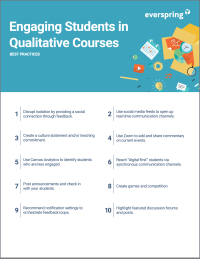Search
There are 25 results.
Category
Tag
Tag
All (63)
Active Learning (4)
Activities (3)
Analytics (4)
Assessments (7)
Asynchrony (6)
Backwards Design (1)
Canvas (9)
Case Studies (1)
Collaboration (3)
Communication (6)
Community (6)
Content Creation (9)
Course Maintenance (4)
Course Materials (3)
Course Preparation (3)
Discussions (4)
Faculty Presence (9)
Faculty Support (2)
Feedback (3)
Formative Assessments (4)
Game-Based Learning (2)
Gamification (1)
Generative AI (3)
Grading (3)
Images (1)
Inclusion (1)
Multimodality (7)
Qualitative courses (1)
Quantitative courses (1)
Revising (2)
Rubrics (1)
Social Media (1)
Summative Assessments (1)
Synchrony (8)
Third-Party Tools (1)
Universal Design for Learning (UDL) (2)
Video (2)
Visual Design (1)
Increasing Engagement With Announcements
Announcements are an essential aspect of online course engagement. When surveyed, students rated “sending regular announcements or email reminders” as one of the most beneficial engagement tactics that an instructor can employ (Martin & Bolliger, 2018, p. 216). In Canvas learning management system (LMS), announcements have a distinct advantage over inbox messages or whole-class emails, as announcements allow students to locate important course information in one convenient location, chronologically arranged. In contrast, email or inbox messages can become much more unruly, rendering information harder to find—especially after the course ends. In addition, most students should receive an email every time an instructor posts an announcement.
Zoom Into Online Learning
Faculty often express concern over how to maintain personal relationships with their students in an online course space; incorporating optional synchronous elements to an online course can help “put a face” to a name. Zoom, the video conferencing tool that allows you to create synchronous experiences for their students, has become ubiquitous in educational and businesses in the past two years.
Best Practices for Online Office Hours
Office hours, blocks of time designated for faculty and student interaction outside of any regularly scheduled class sessions, are routinely incorporated into university courses (Briody et al., 2019; Hsu et al., 2022). Such sessions are often semi-structured and optional for students, allowing faculty to provide customized support to individual learners when needs arise. This form of faculty-student interaction can support academic achievement, retention, and engagement (Griffin et al., 2014; Guzzardo et al., 2021). That office hours attendance is often at the discretion of individual students, however, can result in underutilization of this valuable supplement to required course sessions and contents (Briody et al., 2019; Griffin et al., 2014; Smith et al., 2017). The purpose of this blog is to delineate empirically guided strategies for optimizing the inclusion of office hours in university courses. In particular, we focus on office hours hosted online, as the online modality can be advantageously employed not only for courses delivered online but also for those delivered residentially.
Managing Files in Canvas
Students and instructors alike benefit from consistent file management in online courses. Ensuring that students can readily locate and access the files they need serves to promote engagement and completion of course requirements. Similarly, consistent file management helps instructors to navigate through and update materials efficiently and to avoid introducing file-related errors. This post outlines recommendations and key considerations for optimizing file management within your online course. While recommendations and considerations related to Canvas-specific functionality are threaded throughout, you will also find broadly applicable tips pertinent to multiple learning management systems.
Updating Your Syllabus
Over time, you may want to make changes to the syllabus of a course. The syllabus documents are saved in the “Files” area (1) of the course. To preserve the integrity of the document, the Word document is located in the “Instructor Only” folder (3), and the PDF is found in the “Documents” folder (2) so it is visible to students.
Basic Editing in Canvas
To edit a page in Canvas, simply click on the “Edit” button. Each page contains a variety of editing tools, similar to those found on most word processing programs. The Rich Content Editor applies the principles of a WYSIWIG editor (What You See is What You Get) and uses icons to illustrate the functions. You may also hover over an icon to confirm its function.
Encouraging Effective Discussions
Online forums are valuable learning tools: they merit the time and thought it takes to create them, but they must be well-designed to be effective for instructors and students. Baker and Ahlegren (2022) note that instructors may start out with the best of intentions and a desire to achieve multiple goals, such as promoting critical thinking and fostering a community of authentic learners. However, discussion boards often become just another writing assignment, a missed opportunity to “elicit debate, inspire meaningful ideas, and fully engage the learning community” (Blakely et al., 2022, para. 6). When this happens, students can view discussions as transactional, not transformative.










